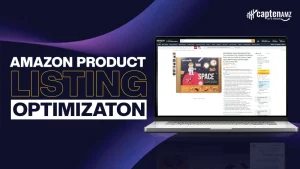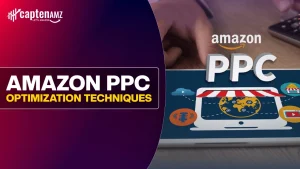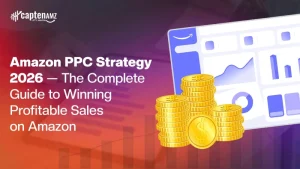If you’re an Amazon seller facing setbacks in 2025, you’re not alone. The landscape has undergone rapid changes due to advancements in AI, stricter compliance requirements, increased ad competition, and evolving customer expectations.
This Amazon Seller Guide 2025 is designed for those actively facing harsh realities, including brand owners, private label sellers, and FBA entrepreneurs seeking actionable ways to turn things around.
1. Assess Where You Are: Why You’re Struggling
Before applying fixes, you need clarity. Here are some root causes for poor performance:
- Low visibility and poor keyword indexing
- High ACOS with little return
- Inventory issues causing stockouts or storage fees
- Listing suppressions and policy violations
- Inconsistent sales despite running ads.
If these sound familiar, you’re exactly who this Amazon FBA survival guide was written for.
Self-auditing is your starting point. Review your business holistically, traffic, conversions, ad spend, and customer feedback. Recognizing patterns (like seasonal slumps or keyword drops) can give you clarity on where to focus next.
If you’re struggling with optimizing your listings, check out our blog on How Amazon FBA Listing Creation Services Can Boost Your Online Business.
2. Step-by-Step Struggling Amazon Seller Help Plan
Here’s how to fix the chaos and build a stable Amazon business again:
a. Optimize Your Listing for Buyers and Rufus

Start with a complete listing audit:
- Are your product titles mobile-optimized?
- Do your bullets address buyer pain points?
- Is your A+ content visually persuasive?
- Are you using Rufus AI Amazon optimization insights?
With AI-powered shopping tools taking over, it’s not just about stuffing keywords; it’s about understanding user intent. Keywords must match buyer queries, which is why you need to include emotional triggers in your bullets.
Leverage Amazon listing optimization tips by improving readability, keyword placement, and product imagery. Include comparison charts and testimonials if you’re enrolled in Premium A+.
b. Improve Ranking With Strategic Keywords

To succeed in ranking on Amazon in 2025, you need to target:
- Long-tail buyer-intent keywords
- Competitor-based keyword gaps
- Seasonal and trend keywords
Use tools like Helium 10, Data Dive, or Amazon’s Brand Analytics to see real-time keyword shifts. Monitor your search query performance weekly.
Also, check for Amazon product listing issues, such as indexing failures or suppressed keywords resulting from incorrect backend entries.
c. Audit & Fix Your PPC
Many sellers are bleeding money through poor ad structure. Use this Amazon PPC strategy 2025 checklist:
- Stop running all match types in one campaign
- Segment branded vs non-branded keywords
- Launch low-bid discovery campaigns to test search terms
- Use bulk sheets for keyword-level optimization
Your Sponsored Products campaigns should support your organic rank goals. Monitor exact match campaigns against your main keywords.
Need to reduce ACoS Amazon PPC? Switch to placement modifiers, leverage budget rules, and monitor your bids daily. Test video ads and lifestyle images, as they are converting better than static product-on-white images in 2025.
Also read: What is Amazon PPC? A Complete Beginner’s Guide
3. Fix Your Inventory Flow
One of the most significant Amazon FBA inventory problems is poor demand forecasting.
Here’s how to fix it:
- Use restock limits to guide launch pacing
- Monitor inbound receiving times
- Align advertising with actual stock levels
- Bundle slow-movers to reduce long-term storage fees
Don’t overlook your IPI (Inventory Performance Index) score. Low IPI can limit your restock capacity. To boost it, clean out stranded inventory, resolve SKU issues, and remove excess inventory every month.
A common issue: You push sales, but Amazon shows a stockout message mid-day, killing momentum. Always keep 2 weeks of buffer stock in FBA and the rest in FBM or a 3PL.
4. Improve Account Health Fast

Struggling with suspensions or warnings? Your account health Amazon seller dashboard is your best friend.
Here’s what to monitor daily:
- Voice of the Customer (return reasons)
- Performance notifications
- Intellectual property complaints
- Product compliance documentation
Open cases immediately and track them in a spreadsheet. Delay can result in a full account suspension. Additionally, keep your business insurance and relevant documents readily available for any account verification requests that may be made.
5. What to Do When Sales Drop

This is the #1 question sellers ask: “What to do when Amazon sales drop?”
Short-term fixes:
- Test price drops with a 7-day deal
- Add secondary images that answer buyer objections
- Reposition your title based on top-converting keywords
Long-term fixes:
- Launch cross-promotions via email or social media
- Tap into Amazon seller growth hacks like post-purchase funnels and product inserts
- Consider launching a second variation or bundle
You can also introduce a subscription model if you’re in a consumable category. Recurring sales stabilize revenue.
6. Leverage Rufus & Amazon’s AI Features
In 2025, Rufus AI Amazon optimization is no longer optional; it has become the new norm.
Use it for:
- Understanding how buyers phrase questions
- Seeing what product traits drive conversions
- Getting content suggestions based on sentiment data
Optimize your product listing and A+ content using these insights. Amazon rewards high engagement metrics.
Sellers who provide Rufus with the correct data, such as rich alt text, descriptive bullet points, and clean, structured backend fields, are being prioritized in search visibility.
7. Growth Tips for Scaling Back Up

Use this plan to grow again:
- Build a storefront with a brand story
- Create a 90-day content and PPC calendar
- Outsource repetitive tasks so you can focus on strategy
- Use brand analytics to track keyword share
Implement these Amazon seller troubleshooting strategies weekly:
- Analyze your click share vs conversion share
- Review your category’s top-selling ASINs for pricing and placement
- Test product videos and comparison charts in A+ Premium
Try influencer-safe listing for external traffic. It can establish a long-term brand presence and drive sales without relying solely on Amazon ads.
Additionally, consider using Shopify or TikTok Shop as your secondary channel. Diversification gives you better bargaining power and reduces dependency.
8. Expand Beyond Amazon: Multi-Channel Selling
Sometimes, Amazon isn’t enough. Consider:
- Building your Shopify store
- Selling on Walmart Marketplace
- Creating digital funnels via Klaviyo or Mailchimp
- Using Etsy or Faire for niche products
Multi-channel expansion reduces risk. If your Amazon account is suspended, you still have revenue streams to lean on.
9. Brand Building for Long-term Success
Amazon is crowded. Branding is your moat.
- Focus on lifestyle branding through packaging and social proof
- Encourage reviews through inserts and emails
- Build brand authority with blogs, videos, and community-building
A strong brand converts more effectively, attracts repeat buyers, and enables premium pricing. Explore strategies in How to Build a Memorable Brand on Amazon.
10. Use Customer Feedback as a Growth Tool
Many struggling sellers overlook the goldmine in customer reviews and returns data. If you’re receiving frequent returns or low ratings, use that feedback to improve your product and listing content.
Here’s how to leverage it:
- Analyze the “Voice of the Customer” dashboard weekly
- Identify common complaints and address them directly in your images, bullets, or inserts
- Use positive reviews as social proof in A+ content or Amazon Posts
This helps reduce returns, build credibility, and even gain insights for product development. Want help translating reviews into conversions? Read How to Use Customer Feedback to Improve Amazon Listings.
11. Master the Art of Amazon Content Marketing

In 2025, content marketing for Amazon sellers is no longer optional; it’s a strategic necessity.
Tips to win:
- Write helpful blog content tied to your brand store
- Use social media content to direct buyers to your storefront
- Run external ads that link to Amazon or a lead-gen funnel
By sharing content that educates, inspires, or solves buyer problems, you stay top-of-mind and improve brand recall.
12. Stay Ahead with Amazon Trends and Tech
Amazon changes fast. Stay ahead by watching trends like:
- Growth of visual commerce (videos and shoppable images)
- Expansion of voice and chat-based shopping (AI like Rufus)
- Rise of sustainability-conscious buyers
Subscribe to newsletters, follow seller communities, and test beta tools. Sellers who adapt early reap the most significant rewards.
13. Build a Winning SOP System
One primary reason sellers burn out? No systems. Every successful seller eventually needs standard operating procedures (SOPs).
Create SOPs for:
- Product research and launch
- Listing creation and optimization
- PPC audit and reporting
- Customer service and review requests
Documenting your workflow saves time, reduces errors, and helps your team scale. We’ve covered this in How to Create SOPs for Amazon Business.
14. Understand Your Buy Box Strategy
Winning the Buy Box is crucial for maintaining consistent sales, especially in competitive categories. Losing it, even for a few hours, can kill your momentum.
Tips:
- Keep prices competitive without undercutting too much
- Monitor your seller metrics: shipping time, feedback, response rate
- Avoid frequent stockouts, as they lower Buy Box eligibility
Using a repricer tool can help automate this. If you’re a brand owner, enroll in Amazon’s Brand Registry to reduce hijacker risks. For deeper insight, explore How to Win the Buy Box in 2025.
15. Utilize Amazon Posts & Brand Story Sections

Many sellers underuse Amazon Posts and the Brand Story feature, yet they’re free visibility tools.
Best practices:
- Post lifestyle images regularly under your brand’s feed
- Highlight brand values and behind-the-scenes in Brand Story
- Repurpose Instagram content for Posts
These tools enhance customer trust and help drive cross-ASIN traffic. Read How to Leverage Amazon Posts for More Sales.
16. Reinforce Customer Retention with Inserts & Email
Acquisition is expensive; retention is where profits grow. Smart sellers now invest in:
- Branded inserts with QR codes or warranty offers
- Follow-up emails through tools like FeedbackWhiz or JungleMail
- Subscription models for consumables (e.g., coffee, supplements)
This helps build repeat purchases and reviews.
17. Prepare for Seasonal Events the Right Way
Holidays and peak seasons (Prime Day, Black Friday, Q4) make or break many sellers. Here’s what to do:
- Finalize deals and listings 30–45 days ahead
- Create seasonal-themed images or bundles
- Increase ad budget slightly 1–2 weeks before events
Failure to plan can result in missed sales or costly stockouts.
18. Protect Your Brand with Trademark and IP Monitoring
If your brand is vulnerable to hijackers or counterfeits, take action:
- Register your trademark and enroll in the Brand Registry
- Use Amazon Transparency to track authentic units
- Monitor listings with IP tools like Red Points or Helium 10 Alerts
This keeps your brand secure and protects the integrity of your product.
19. Analyze Your Competitors Ruthlessly
You can’t grow if you don’t know who you’re up against. Competitor analysis should include:
- Tracking their keyword ranks
- Reverse-engineering their PPC structure
- Studying their reviews for patterns
Set up alerts to watch when they launch new variations, update images, or change prices.
20. Consider Agency Support to Scale Faster

DIY works until it doesn’t. When you hit a growth ceiling, bringing in experts can help you:
- Fix PPC leaks and improve ROI
- Create better-performing creatives and storefronts
- Uncover hidden catalog issues
CaptenAMZ has helped over 200+ brands scale profitably.
Final Words
If you’ve read this far, you’re already ahead of 80% of sellers still throwing money at problems. This Amazon Seller GuideSeller Guide 2025 provides a battle-tested framework to help you transition from stuck to scaling.
Remember: surviving as an Amazon seller in 2025 isn’t about luck. It’s about systems, clarity, and execution.
Whether it’s fixing PPC, managing inventory, or reclaiming visibility, this Amazon FBA survival guide is your blueprint.
Continue testing, continue learning, and if needed, seek expert assistance. Don’t let inaction be the reason your brand disappears.








